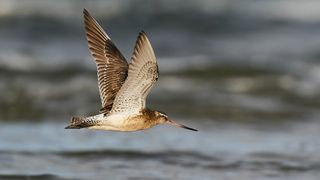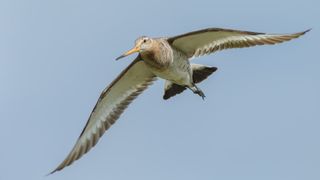Juvenile bird accidentally breaks record for longest non-stop flight on its first attempt
A 5-month-old bar-tailed godwit recently flew non-stop for 265 hours as it migrated more than 8,000 miles from Alaska to Tasmania.

A juvenile bird recently broke the world record for the longest continuous bird flight on its very first long-haul journey across the Pacific, after the youngster got mixed up and accidentally landed in the wrong place.
The bar-tailed godwit (Limosa lapponica), known simply by its satellite tag number 234684, flew 8,435 miles (13,575 kilometers) from Alaska to Tasmania, an Australian island state south of the mainland, according to a Facebook post from the Pūkorokoro Miranda Shorebird Center in New Zealand. The youngster, which is around 5 months old, took off Oct. 13 and finally touched down Oct. 25 after flapping its wings non-stop for 11 days and 1 hour, or 265 continuous hours.
The previous record holder was another bar-tailed godwit, an adult male known as 4BBRW, which flew 8,100 miles (13,035 km) from Alaska to New South Wales in Australia in October 2021, according to The Guardian. In doing so, the same bird ended up breaking its own personal best of 7,500 miles (12,070 km) from Alaska to New Zealand, which it set in October 2020.
Related: 10 of the biggest birds on Earth
Most bar-tailed godwits finish their migrations in New Zealand or mainland Australia. However, satellite data reveals the young record-breaker made a wrong turn late in the route, on its approach to New Zealand; it flew between the two countries and ended up on the wrong side of Australia.
Experts suspect that this navigational mishap was caused, in part, because the bird had no idea where it was headed.
Juvenile bar-tailed godwits make their maiden migration up to six weeks after their parents have already flown south for the winter — which is unusual for birds, Sean Dooley, editor of the magazine Australian Birdlife, told The Guardian.
Sign up for the Live Science daily newsletter now
Get the world’s most fascinating discoveries delivered straight to your inbox.

The delayed departure time enables the youngsters to spend more time fattening up before they head out on their energy-sapping journey with other first-timers. Normally this isn't an issue, and most juveniles manage to eventually meet up with the adults, despite having never traveled to their final destination before.
Researchers are still unsure how these birds manage to pull off this astounding feat of navigation. However, the birds normally migrate in large flocks, Dooley said, which may help them collectively work it out.
It is unclear if the young godwit was alone or not when it reached Tasmania. But it’s possible that it became separated from its flock and ended up following other migrating birds from different species to Tasmania, according to BBC Newsround.
Unlike seabirds such as gulls, which can effortlessly glide for great distances across the oceans by coasting on wind currents, bar-tailed godwits are active flyers, which means that they have to flap their wings almost constantly. This uses up a lot of energy, and individuals can lose up to half of their body weight during their migrations, Eric Woehler, an ornithologist at the University of Tasmania and head of the conservation group BirdLife Tasmania, told BBC Newsround.
The youngster's "wrong turn" revealed important new information about bar-tailed godwits, Woehler said. It was previously assumed that non-stop flappers were pushing themselves to the absolute limit during their mammoth migrations, but the new finding shows they can go even farther than expected, he added.

Harry is a U.K.-based senior staff writer at Live Science. He studied marine biology at the University of Exeter before training to become a journalist. He covers a wide range of topics including space exploration, planetary science, space weather, climate change, animal behavior, evolution and paleontology. His feature on the upcoming solar maximum was shortlisted in the "top scoop" category at the National Council for the Training of Journalists (NCTJ) Awards for Excellence in 2023.
Most Popular

